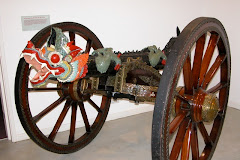Rifling was a system of grooves cut in a spiral along the lining of the barrel. The projectile's surface was forced into following the spiralling grooves, emerging with a constant, defined spin. This had two advantages: first it provided a predictable effect that could be compensated for; second it provided stability along the trajectory due to the gyroscopic effect of the spin. This became particularly important for artillery when it moved from firing spherical shot and shells to cylindrical munitions.

Unlike a spherical shape which presents the same aspect to the air all along its trajectory, unspun cylindrical projectiles from a smoothbore are quickly forced by air pressure to present their largest surface to any resistance and hence tumble in flight, severely affecting both range and accuracy. To avoid this they need to be gyroscopically stabilized by spinning, or else fitted with fins. Tail fins, like the feathers on arrows, can stabilize a projectile in flight. However, while there are occasions when fitting fins is a useful option, it is not regarded as a good solution for the bulk of "tube" artillery because the fins add to design problems inside the barrel.
Attempts were made to introduce a form of rifling quite early (as far back as the middle of the 15th Century), and by the 17th Century it was shown to be effective in sporting weapons. However, it was considered to be too expensive for military use until the end of the 18th Century, and even then it was only used for specialized troops like sharpshooters. It was still not taken up in the artillery world because it was not considered necessary, but all that changed in the 19th Century.
One of the major factors driving the change was the recognition that the weight of fire from a given calibre of gun could be significantly increased by moving from a spherical munition to a cylindrical shape: it meant that the projectile could contain a much larger amount of explosive. To get that amount of explosive inside a spherical shape would mean a larger diameter ball and in turn a larger diameter barrel and a heavier gun.
But rifling had a significant disadvantage: it was much harder to load a gun by pushing the projectile down the barrel from the muzzle end, as had been the practice with smoothbores. That meant opening the back (breech) end of the barrel and then having to close it with sufficient strength in the design to cope with the very high pressure in the chamber on firing. Solving this problem is a big subject that I will tackle in another article.




No comments:
Post a Comment